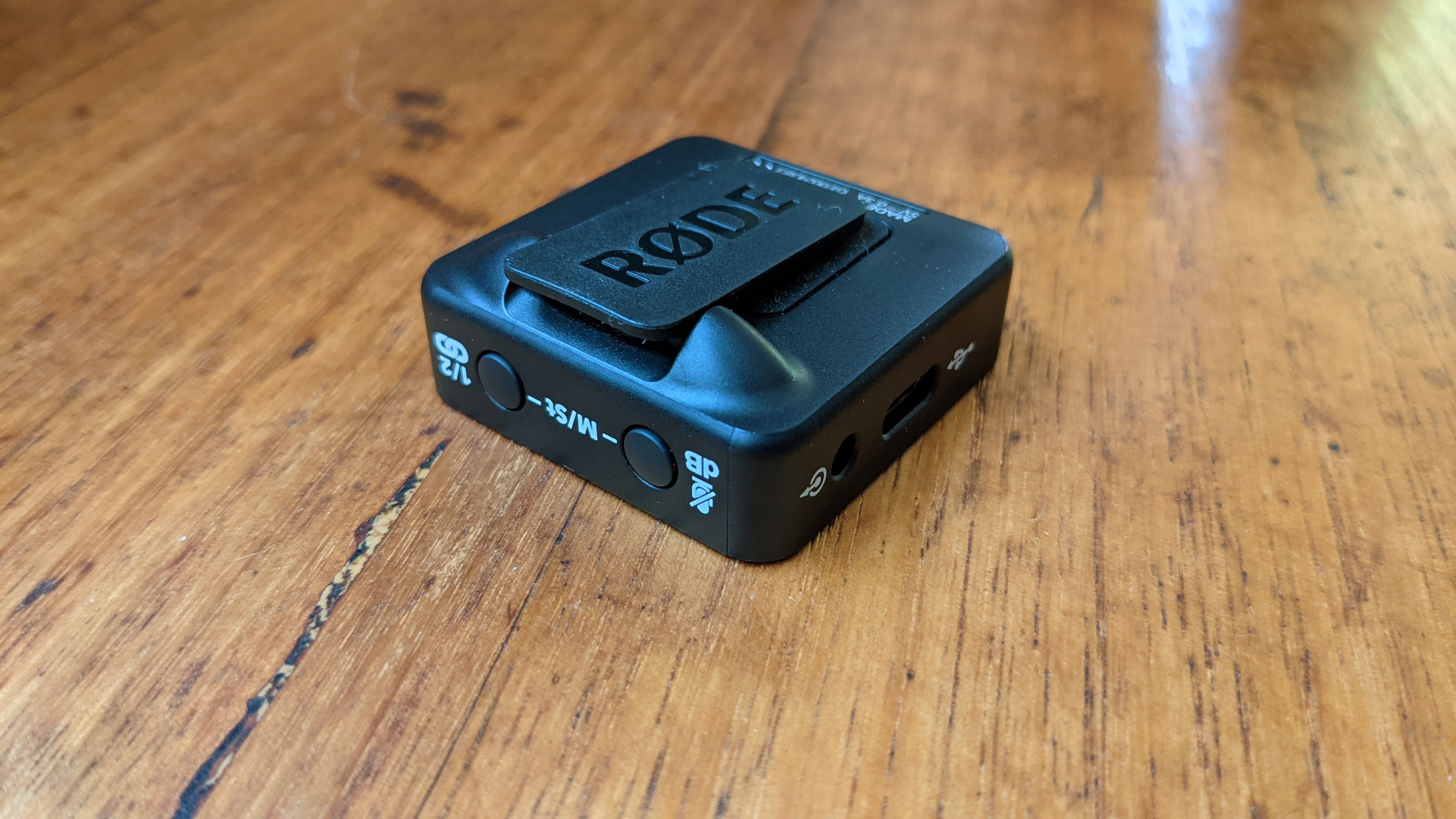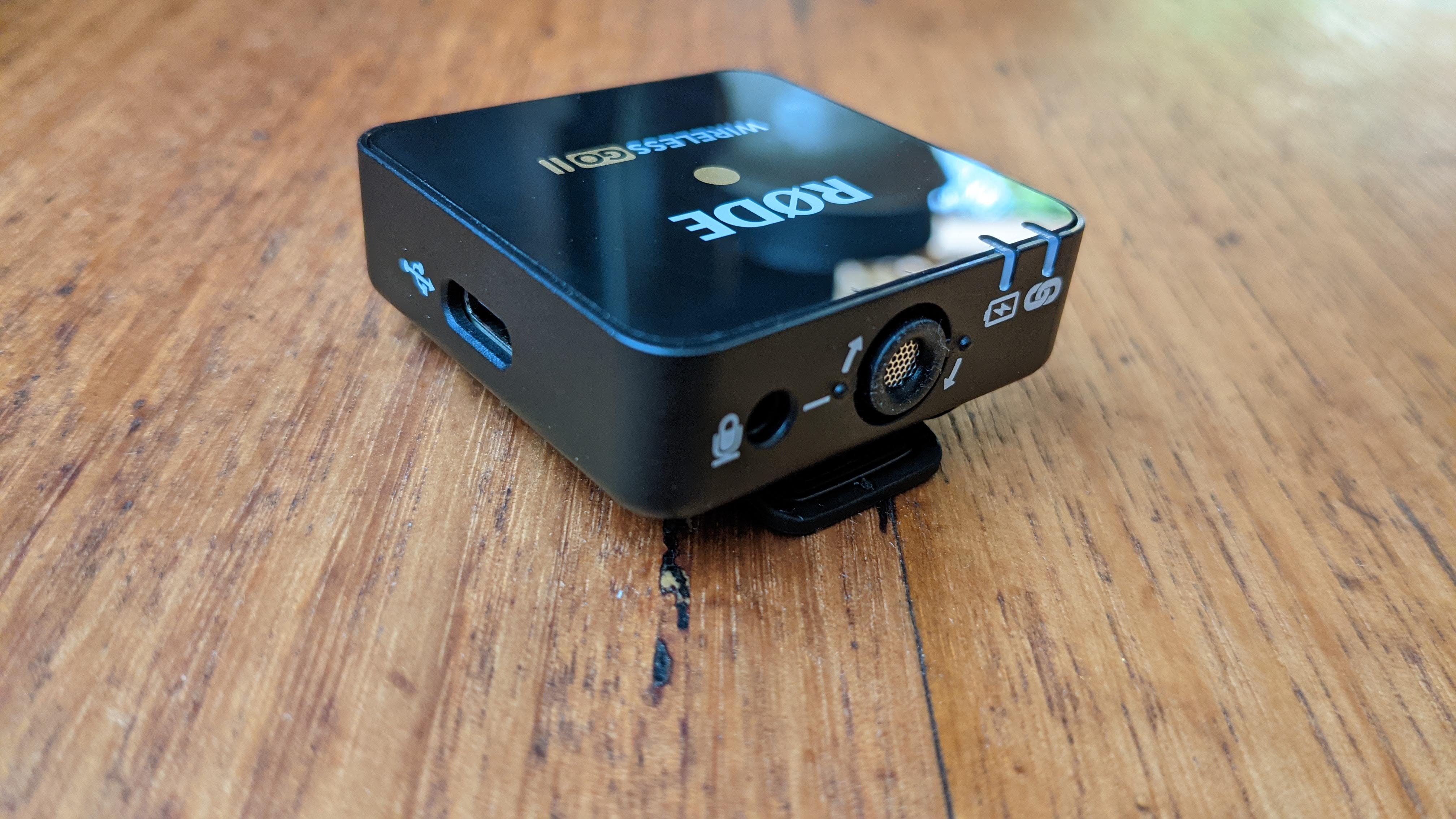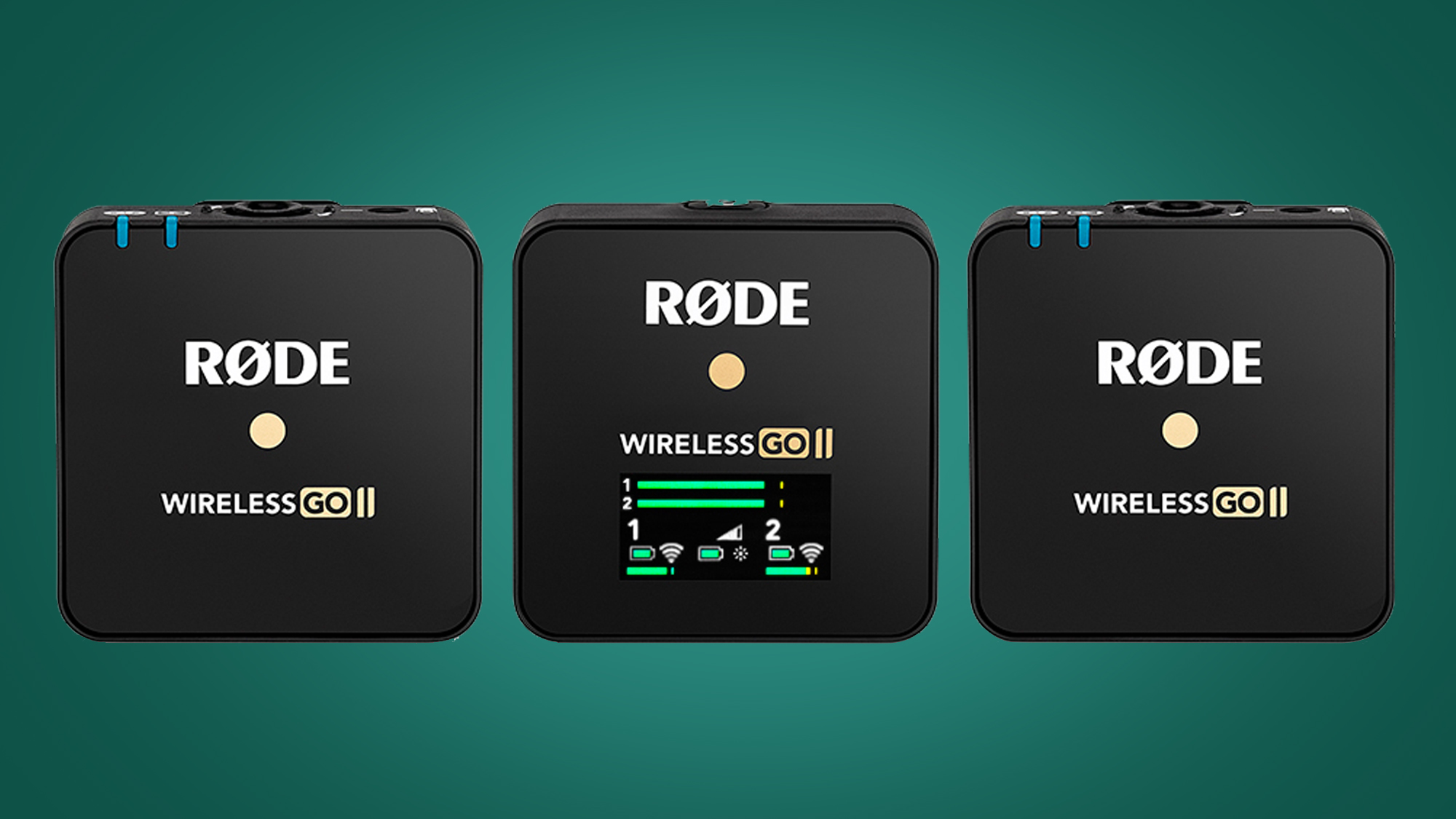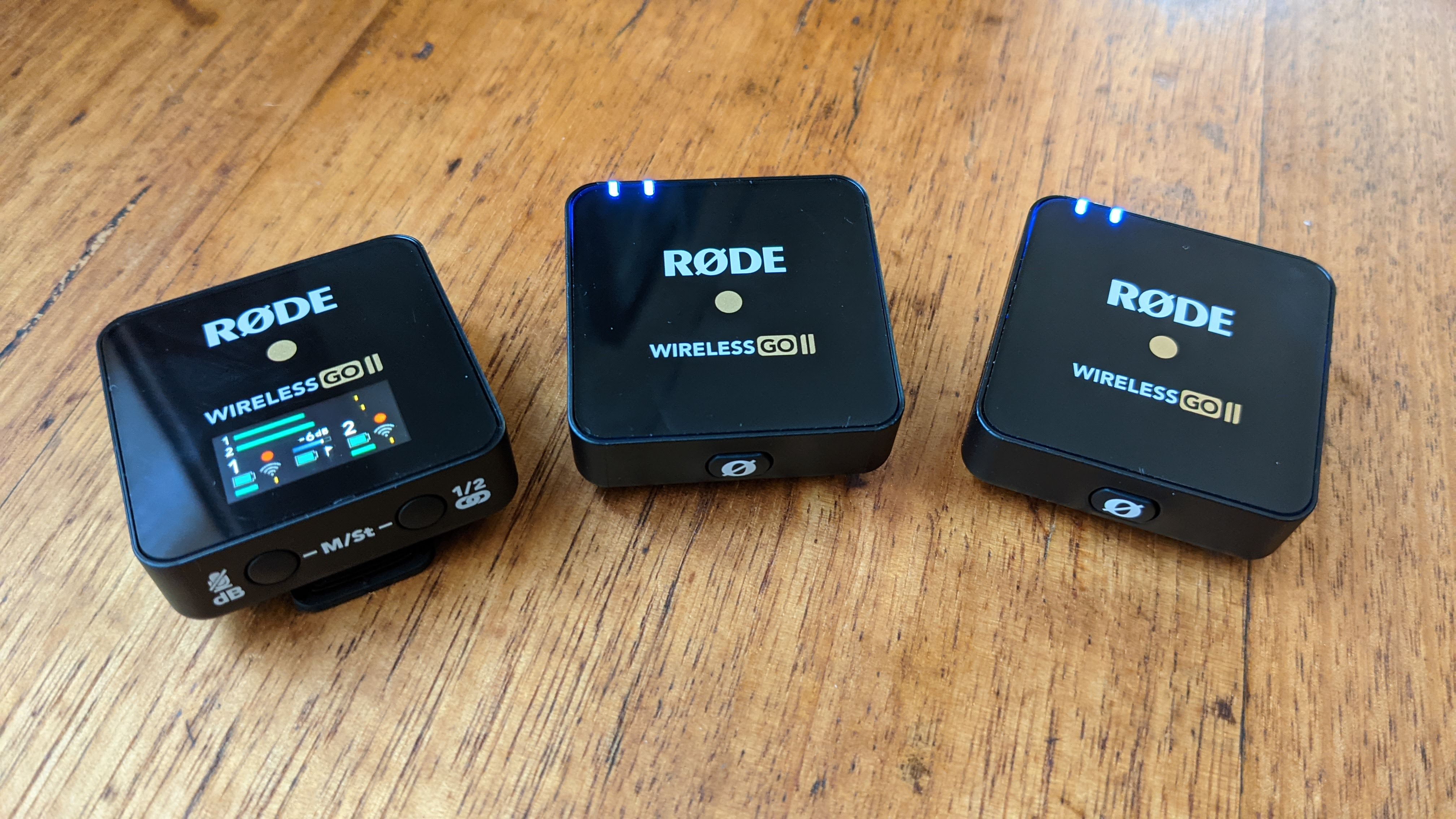TechRadar Verdict
If your goal is to transmit and record two independent audio sources wirelessly over great distances, then the Rode Wireless Go II is your solution. This kit offers a wealth of clever options in an incredibly intuitive package, and does so for a significantly lower price than it has any right to.
Pros
- +
Compact and powerful
- +
Intuitive operation
- +
On-board storage
Cons
- -
Pricier than predecessor
Why you can trust TechRadar
Two-minute review
Rode’s first Wireless Go product was a game-changer in the industry – an ultra compact and foolproof wireless transmitter and receiver with an integrated microphone, all for an affordable price.
Rode’s next-in-line (the aptly titled Wireless Go II) improves on just about every area, taking its place alongside its sibling as a highly recommendable tool for video and audio content creators everywhere.
Most notably, the Wireless Go II features two transmitters and one receiver, whereas its predecessor only offered a single transmitter. This comes with a notable 40% price jump, but it’s more than reasonable given the extra hardware and increased functionality of the complete package, and the original unit’s still available if you do just want a single transmitter.
- These are the best YouTube cameras you can buy right now
- Or check out our guide to the best vlogging cameras
The wireless connectivity has been bumped up too, with a 200m line-of-sight range rather than 70m, and the addition of on-board storage for each transmitter means that you can record over 40 hours of compressed audio separately onto each device, making for an excellent redundancy measure or a standalone recorder in a pinch.
The size and design of the units remains largely the same – a plus – with each unit presenting a compact form factor with minimal yet powerful controls and displays, and a rechargeable battery capable of 7 hours of runtime.
As Rode is known for, the recording quality of the transmitter’s integrated microphone is great, although most users will likely pair them with an external lapel/lavalier microphone running to the transmitter’s input.
For videographers, vloggers, podcasters or anyone working within the creative audio space, the Rode Wireless Go II system is a low-fuss, high-quality solution for recording two sound sources simultaneously and remotely. If you’re really not needing a second transmitter, then the original (and likely discounted) Rode Wireless Go is your best option, but even then, the Go II kit may still be worth the investment.
Price and availability
- Rode Wireless Go II is out now
- Rode Wireless Go II price: $299 / £279 / AU$399
The Rode Wireless Go II is available now for $299 / £279 / AU$399. While the original Rode Wireless Go retailed for $199 / £179 / AU$279, it isn’t being replaced by the Go II, so will likely be found discounted here and there while sold alongside its newer sibling.
Design and updates
- Two transmitters rather than one
- Compact and lightweight
- On-board storage in transmitters
As we’ve mentioned, much of the design finesse that made the original Wireless Go groundbreaking has returned with the Go II, but the updates that have made their way into this release have done wonders to improve overall quality of life.
The units themselves are really small for what they promise, with each measuring around 44 x 45 x 18mm and weighing only 30g. Despite this lightweight and compact design, they feel rather robust, although we wouldn’t want to push this assumption with too many drops and there’s no weatherproofing.
The plastic clips are quick and simple to operate when affixing any of the units to clothing, and they double as a hot shoe mount to neatly slot on the top of your camera kit.
These clips along with the compact form factor make them ideal for attaching to a belt in order to run a lavalier microphone, or clipping closer to the wearer’s mouth (in a jacket or even dress) to use the integrated microphone.
Each unit houses a rechargeable battery that promises 7 hours of activity, and each can be charged via its USB-C input. Three USB-C cables are included with the kit for simultaneous charging, along with two furry windshields, a carry pouch, and a 3.5mm TRS cable to hook directly into your camera or other device. Smartphone cables (Lightning and USB-C) are available separately.

Aside from the 3.5mm and USB-C ports, there’s little else to clutter the Wireless Go II – each of the devices has a multi-purpose button (more on this later), the transmitters sport a microphone and two indicator lights (to display power and connectivity), and the receiver features an extra two buttons and a screen that indicates recording level, battery life, signal strength, and a few other crucial details.
Where the original promised a 70 metre line-of-sight range, both transmitters in the Go II package can handle 200 metres. While this measurement is a best-case scenario from Rode, we certainly noticed an improvement in stability over longer distances (whether or not it’s almost triple that of the original unit is difficult to say, but we don’t doubt it).
One point worth noting is that the Wireless Go II transmitters and receivers aren’t compatible with the original units, and vice versa. We imagine this has to do with the improved transmission technology mentioned above, but it’s worth considering if you were hoping to add more of either device to your existing fleet.

- Check out our roundup of the best podcasting gear on the market
In use
- Quick, intuitive setup
- Thorough software for tweaking
- Great quality and signal strength
The setup for the Rode Wireless Go II is one of the easiest out there for products in this category, with everything ready to go as soon as you take it out of the box. For those that like to dig in and customize their kit, there’s plenty of fine-tuning available either via the receiver’s buttons or the Rode Central app.
The software gives you the ability to access all the settings for your device, and includes nifty features like setting up what the multi-function button does on the transmitters and receiver, such as mute, set a marker, or enable the backlight.
It’s in this software that you’ll also be able to access the recordings stored directly on each transmitter, as well as configure the audio’s settings. You can choose to record uncompressed or compressed audio, giving you either seven hours of recording time or over 40 respectively, as well as view any placed markers in order to quickly find a good take or key moment.
Some other key features accessible via the software include fine gain control, for setting precise levels rather than the set increments available by the hardware buttons, as well as establishing a safety channel – a genius feature that records the same signal at a lower volume in case the main channel clips and you lose audio.
While the software is a great way to view each and every setting for your Rode kit, a lot can be done with the hardware alone. Changing from the default merged channel to split-channel, for instance, is done by holding both the dB and link buttons simultaneously for three seconds. This latter option allows each transmitter to record its audio separately so you can later mix the two to your liking.
We’ll avoid covering all the tweaks and features exhaustively, but instead say that we certainly weren’t left wanting whenever we needed to adjust something or modify how the Wireless Go II operated.
The hardware buttons and screen do a great job in allowing access to crucial functionality, and the Rode Central software is incredibly user-friendly and covers everything else you could need.
As for the audio itself, the integrated microphones in the transmitters produce excellent quality recordings, as Rode is known for, and you can plug in any external mic to the TRS connection if you have a preference for lavalier mic or similar.
To ensure there’s even less of a chance of quality loss, you can connect the receiver to your camera or smart device directly via USB-C, which bypasses the analog audio signal conversion in the receiver entirely, allowing for only one analog-to-digital conversion to occur at the microphone end of the system.

Buy if
You need to record two subjects at once
The key feature of the Rode Wireless Go II is the inclusion of two transmitters, allowing you to send two signals simultaneously to the receiver and either preserve them as individual channels, or merge them into a single audio file (with the option of a safety channel).
You want quality equipment on a budget
Considering all that’s on offer, the Rode Wireless Go II is very reasonably priced. For a set of robust and professional transmitters and receivers – with on-board storage, rechargeable batteries, integrated microphones and brilliant design – you won’t find anything else quite like it for the cost.
You need a compact and lightweight recording solution
As mentioned, both the transmitters and receiver are incredibly light, weighing around 30g apiece, and are rather small for what they promise, making them easy to lug around and similarly simple to attach to your talent.
Don't buy if
You just need a microphone
While this system features integrated microphones, the bulk of what you’ll be paying for is the brilliant wireless transmission and all the clever features associated with it – there are plenty of dedicated microphones for far less if that’s what you need.
You only need one transmitter
The original Rode Wireless Go is still a perfectly capable unit, and while it doesn’t have all the upgrades of the newer model, it'll be better value for you if you only need a single transmitter and can find it at a discount.

